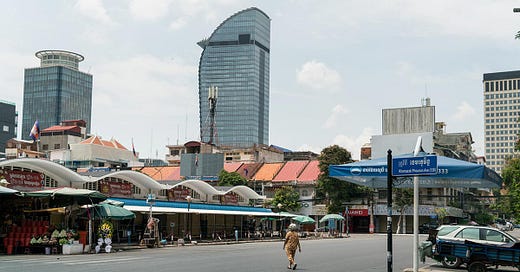Sou Sdei and welcome to Campuccino, your fortnightly dispatch of key headlines in Cambodia with a dash of opinion.
A warm welcome to new subscribers, thank you for allowing me into your inbox. It’s nice to have you here.
It’s been only two weeks since I last wrote to you, but it felt like two lifetimes ago for me. Days jumbled together as I’m trying to find a work-life balance after having started a new role last week working mostly on Cambodia time. Meanwhile, Phnom Penh as I knew it has been transformed into one that causes this unsettling feeling in my stomach. People are dying and starving, and I have this guilt of being in my modern city apartment thousands of kilometres away, full meal on the table and not able to help. No amount of donation can ease this guilt so far. How do you reconcile this feeling?
- Darathtey
In this issue: inequalities, failed policies, and starvation.
More than one year into this pandemic, we have learned that lockdowns unearth inequalities in many societies. Cambodia is no exception. Personally, I’ve always recognised that I belong to a specific social bubble, yet this lockdown in Cambodia has privilege written all over me and many people in my circle. I feel like I’m standing at this vantage point observing a heartbreakingly stark contrast in Cambodian society. On the one hand, I’m happy that those I know only have to deal with boredom being locked in their homes waiting out the Covid-19 storm. On the other hand, I see other people, forced to confine themselves in a space I would never consider a proper home, having their basic needs threatened.


While the city of Phnom Penh and its adjacent Takhmao were put into lockdown, four communes and three villages were declared red zones, in which people cannot leave their homes at all, and even food vendors had to close down. The lockdown, which was supposed to last for two weeks, has since been extended for one more week. Now, areas in both Phnom Penh and Takhmao are divided into zones with colour systems – red, orange, yellow. An interactive map with an explanation of what each zone colour means can be found on the VOD website here.
It is undeniable that the lockdown affects everyone, but the city’s already vulnerable populations have been severely impacted. An article in Southeast Asia Globe illustrates how the Phnom Penh lockdown impacts the city’s most vulnerable labourers. Workers such as moto-taxi drivers, street food vendors, and garment workers have been cut off from their already small daily incomes. In short, they cannot work and barely have access to food or anything else for that matter. Similarly, a report in Nikkei Asia takes a closer look at the struggles of people in Phnom Penh’s red zones. For many, food is running out without concrete and consistent help from the government. Violence has been deployed without proper elaboration. It’s desperation all around. While markets are shut, the Ministry of Commerce is playing vendor only to find out that it does not work.
Meanwhile, in areas surrounding Cambodia’s capital we have farmers struggling to sell off their produce. Between travel restriction and the closure of markets across Phnom Penh, farmers find it very difficult to sell their produce. And when they do manage to find buyers, they are forced to sell it at an incredibly low price, reports Cambodianess.
I’m aware that this all sounds very grim but if you know me you’re aware that I don’t like to brush over anything. I also don’t smile when I’m nervous. I have, however, learned to recognise silver linings and be grateful for the small things over this past year. While the government is still figuring out how to get food to people with closed markets and stalled produce, Cambodians take matters into their own hands and help each other out. Farmers, small vendors and fruit sellers in Prek Bak Village in Loeuk Dek District’s Prek Tonloap Commune donated fruit and vegetables to Phnom Penh and Takhmao with transportation assistance provided by local authorities, according to Cambodianess. Since the lockdown, many individuals and organisations have started many fundraising initiatives to help those who need it the most. Here are a few examples:
Local4lLocal is a youth-run food drive supporting those in need on the streets of Phnom Penh.
COVD Help is a private initiative providing food and hygiene products throughout the city.
Women in the City, an informal solidary network to promote women identity, condition & evolution in Cambodia, has been collecting donations to purchase basic food items and sanitary essentials for the most vulnerable communities.
Visually Pleasing
Arts & Culture
🎥 Cambodia Eats! is a newly released food and travel series by Focus Cambodia to discover unique food across the country and the communities behind them. The first episode features a dish called “Somlor Prong” by the Bunong community in Mondulkiri. I think it is a great show looking to highlight environmental issues through food. However, if I’m being honest, I had to try really hard to get through the first half of the episode because it was full of empty conversation. I felt like the host tried very hard to engage with the locals but the attempt only emphasises disconnection between them. The episode improved at its halfway mark when they began to feel more familiar with each other around plates of food.
Overheard on Twitter


Campuccino is a fortnightly dispatch of key headlines in Cambodia, written by @DarathteyDin from Word & Visual.
I’d love to hear from you. If you have feedback or content ideas, please reach out via tey@wordandvisualmedia.com





